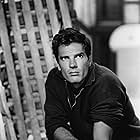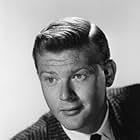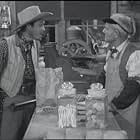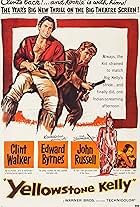"Screaming Eagles" is a historical drama about paratroopers of the 101st Airborne Division fighting during the D-Day Invasion in June of 1944. The title was the Division's nickname."Screaming Eagles" is a historical drama about paratroopers of the 101st Airborne Division fighting during the D-Day Invasion in June of 1944. The title was the Division's nickname."Screaming Eagles" is a historical drama about paratroopers of the 101st Airborne Division fighting during the D-Day Invasion in June of 1944. The title was the Division's nickname.
Photos
Joe Di Reda
- Pvt. Dubrowski
- (as Joe di Reda)
Robert Blake
- Pvt. Hernandez
- (as Bobby Blake)
Robert Dix
- Pvt. Peterson
- (as Bob Dix)
- Director
- Writers
- All cast & crew
- Production, box office & more at IMDbPro
Storyline
Did you know
- TriviaThe uniforms and equipment the U.S. paratroopers wear in the film are fairly realistic for the D-Day period, including the white "card suit" markings the 101st Airborne Division used on the sides of their helmets to identify sub-units in the Division. The paratrooper's helmets in the film carry the heart suit of the 502nd Parachute Infantry Regiment.
- GoofsThe beginning of the movie with the opening credits shows paratroopers jumping from C-119 Flying Boxcar transport aircraft. The first C-119 made its initial flight in November 1947, over 3 years after the period the movie depicts, (June 1944)
- Quotes
Lt. Pauling: Whatever you find, don't try any fighting alone. Ya Got that? We do our fighting together.
- ConnectionsReferenced in Weekend Warriors (1986)
Featured review
"Screaming Eagles" is a very good World War II movie about the airborne role in Operation Overlord, better known as D-Day. This story follows 15 men of a platoon, including the platoon leader, of Company D of the 502nd Airborne Infantry Regiment. The 502nd then was part of the 101st Airbourne Division, known as the Screaming Eagles.
The opening has the men of Lt. Pauling's platoon in England where they have been training for weeks for the assault on northern France. After three new replacements arrive, there are a couple more days before they get the word that D-Day is set for the next day, June 6, 1944. So, that night, they begin the assault phase of Overlord, called Operation Neptune. They are part of more than 13,000 Americans of the 82nd and 101st Airborne divisions that parachute into northern France the night of June 5. The naval bombardment and Allied troop assaults would take place the next day at five landing sites, with beaches named (West to East) Utah, Omaha, Gold, Juno and Sword.
The missions of the airborne units were to secure bridges and block German reinforcements from reaching the coast at Utah Beach. As this film shows, the pilots didn't see the ground signals for drop zones, and when German anti-aircraft guns started firing on the planes, the troops jumped as soon as they could. As a result, the units were spread out and scattered over a large area. While they couldn't get organized to take all of their objectives immediately, the various smaller groups assembled on the ground were able to attack Germans at various locations. The resulting chaos confused the Germans so that they weren't able to mount strong reinforcements. And the Allied landings were soon able to break out of their beachheads.
This story shows the engagements and combat that just one third of Lt. Pauling's platoon encountered. While he was blinded by the flash of a German's luger, Pauling could speak French with a young French woman they rescued when they assaulted Germans held up in her family's farmstead. Marianne, in turn, could speak German, so between them they were able to foil the Germans. When Pauling's group reaches the rest of his platoon who are assembled with their company at the bridge that was their mission,10 of his 15 men have been killed.
The cast all do well in their roles. Among them are Tom Tryon as Private Mason, Jan Merlin as Lt. Pauling, Martin Milner as Pvt. Corliss, Jacqueline Beer as Marianne, Robert Blake as Pvt. Hernandez, Pat Conway as Sgt Forrest, and Edward G. Robinson Jr. As Pvt. Smith.
There is one thing missing from this film - or, that would have been good to include. On June 5, the day before D-Day, the 101st Airborne Division men were paid a special visit by Gen. Dwight D., Eisenhower, the Allied Command-in-Chief. But, considering that this movie was made in 1956, and Ike was then sitting as President of the U. S., it was probably too much to ask him to make a cameo appearance back in uniform. And, of course, with the man himself living, no one was about to suggest a stand-in actor.
Many more movies were made about WW II battles and combat. There have been films that focus on strategic planning, intelligence, and espionage. Combat movies have been made that focus on tanks, artillery, medics and field hospitals. There have been many movies made about aerial and naval combat. But many combat films have been about the infantry in Europe, Africa and Asia; and Marines in the South Pacific. That's because there were far more infantry and Marine units with many more operations and battles. Airborne (parachute) units were mostly infantry who were trained for assaults behind enemy lines and then regular ground fighting. So, while they would be called on for assaults, usually at the start of an operation, most of their time would then be spent engaged in ground combat.
A few other movies show airborne training and/or combat jumps during WW II. They include "Parachute Battalion' of 1941, "Objective Burma" of 1945, the British "Paratrooper" of 1953, "The Longest Day" of 1962, and "A Bridge Too Far" of 1977. Some other movies have been made that have scenes of small groups or individuals jumping behind enemy lines. The 1944 film, "Battleground", is a very good film about the 101st Airborne Division that wouldn't retreat or surrender to the Germans in the Battle of the Bulge toward the end of the war. They held out until George Patton's Third Army arrived to reinforce them and push the Germans all the way back into defeat and surrender.
The opening has the men of Lt. Pauling's platoon in England where they have been training for weeks for the assault on northern France. After three new replacements arrive, there are a couple more days before they get the word that D-Day is set for the next day, June 6, 1944. So, that night, they begin the assault phase of Overlord, called Operation Neptune. They are part of more than 13,000 Americans of the 82nd and 101st Airborne divisions that parachute into northern France the night of June 5. The naval bombardment and Allied troop assaults would take place the next day at five landing sites, with beaches named (West to East) Utah, Omaha, Gold, Juno and Sword.
The missions of the airborne units were to secure bridges and block German reinforcements from reaching the coast at Utah Beach. As this film shows, the pilots didn't see the ground signals for drop zones, and when German anti-aircraft guns started firing on the planes, the troops jumped as soon as they could. As a result, the units were spread out and scattered over a large area. While they couldn't get organized to take all of their objectives immediately, the various smaller groups assembled on the ground were able to attack Germans at various locations. The resulting chaos confused the Germans so that they weren't able to mount strong reinforcements. And the Allied landings were soon able to break out of their beachheads.
This story shows the engagements and combat that just one third of Lt. Pauling's platoon encountered. While he was blinded by the flash of a German's luger, Pauling could speak French with a young French woman they rescued when they assaulted Germans held up in her family's farmstead. Marianne, in turn, could speak German, so between them they were able to foil the Germans. When Pauling's group reaches the rest of his platoon who are assembled with their company at the bridge that was their mission,10 of his 15 men have been killed.
The cast all do well in their roles. Among them are Tom Tryon as Private Mason, Jan Merlin as Lt. Pauling, Martin Milner as Pvt. Corliss, Jacqueline Beer as Marianne, Robert Blake as Pvt. Hernandez, Pat Conway as Sgt Forrest, and Edward G. Robinson Jr. As Pvt. Smith.
There is one thing missing from this film - or, that would have been good to include. On June 5, the day before D-Day, the 101st Airborne Division men were paid a special visit by Gen. Dwight D., Eisenhower, the Allied Command-in-Chief. But, considering that this movie was made in 1956, and Ike was then sitting as President of the U. S., it was probably too much to ask him to make a cameo appearance back in uniform. And, of course, with the man himself living, no one was about to suggest a stand-in actor.
Many more movies were made about WW II battles and combat. There have been films that focus on strategic planning, intelligence, and espionage. Combat movies have been made that focus on tanks, artillery, medics and field hospitals. There have been many movies made about aerial and naval combat. But many combat films have been about the infantry in Europe, Africa and Asia; and Marines in the South Pacific. That's because there were far more infantry and Marine units with many more operations and battles. Airborne (parachute) units were mostly infantry who were trained for assaults behind enemy lines and then regular ground fighting. So, while they would be called on for assaults, usually at the start of an operation, most of their time would then be spent engaged in ground combat.
A few other movies show airborne training and/or combat jumps during WW II. They include "Parachute Battalion' of 1941, "Objective Burma" of 1945, the British "Paratrooper" of 1953, "The Longest Day" of 1962, and "A Bridge Too Far" of 1977. Some other movies have been made that have scenes of small groups or individuals jumping behind enemy lines. The 1944 film, "Battleground", is a very good film about the 101st Airborne Division that wouldn't retreat or surrender to the Germans in the Battle of the Bulge toward the end of the war. They held out until George Patton's Third Army arrived to reinforce them and push the Germans all the way back into defeat and surrender.
Details
- Runtime1 hour 19 minutes
- Color
- Aspect ratio
- 1.85 : 1
Contribute to this page
Suggest an edit or add missing content






























